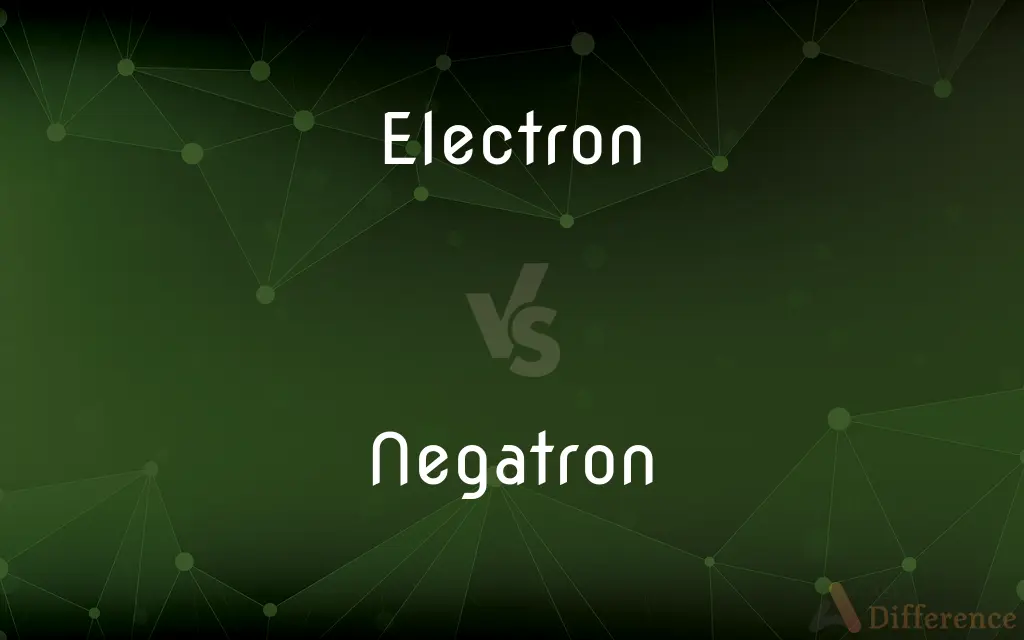Electron vs. Negatron — What's the Difference?
Edited by Tayyaba Rehman — By Urooj Arif — Updated on May 2, 2024
Electron is a fundamental subatomic particle with a negative charge, integral to chemical reactions and electrical conductivity, whereas a negatron is simply another name for an electron, used primarily in scientific contexts.

Difference Between Electron and Negatron
Table of Contents
ADVERTISEMENT
Key Differences
An electron is a key component in the structure of atoms, carrying a negative charge and playing a crucial role in bonding and electricity. In contrast, the term negatron is a less common synonym for an electron, mostly used in specific scientific discussions or historical contexts.
Both terms describe the same particle, essential in both chemistry and physics for its involvement in forming chemical bonds and facilitating electrical flow. While the electron is widely recognized in educational and general science discourse, the negatron is often found in older scientific literature or specific fields like nuclear physics.
The difference in terminology usage highlights how scientific language can evolve, with 'electron' becoming the dominant term. On the other hand, understanding the term 'negatron' can provide insights into the history and development of atomic theory.
While both terms refer to the same entity, the predominance of 'electron' in modern texts simplifies communication among scientists and educators, avoiding the confusion that might arise from using two terms interchangeably.
Comparison Chart
Definition
Fundamental particle with a negative charge.
Alternate name for an electron.
ADVERTISEMENT
Usage
Common in all scientific and educational contexts.
Less common, used mainly in specific scientific areas and older texts.
Charge
Negative
Negative
Role in Science
Central in chemistry, physics, and electrical engineering.
Identical to electron, with limited use in discussions.
Historical Context
Term used universally since the early 20th century.
Used historically, particularly in early nuclear physics discussions.
Compare with Definitions
Electron
Essential in both theoretical and applied physics.
The study of electrons is crucial for developing new electronic devices.
Negatron
Another term for an electron, used primarily in scientific contexts.
The discovery of the negatron was a pivotal moment in nuclear physics.
Electron
The primary carrier of electricity in solids.
In metals, electrons move freely, enabling electrical conductivity.
Negatron
Used historically in discussions of beta decay and other nuclear processes.
Beta decay involves the emission of a negatron from a nucleus.
Electron
Fundamental to chemical bonding and reactions.
Electrons are shared or transferred during chemical reactions to form bonds.
Negatron
Often found in older scientific literature.
Early texts on atomic theory may refer to the particle as a negatron.
Electron
Observable in many physical phenomena such as electricity and magnetism.
Electrons can be deflected by magnetic fields, demonstrating their charge.
Negatron
Reflects the historical development of scientific nomenclature.
The use of negatron in early 20th-century papers helped distinguish different types of beta particles.
Electron
A subatomic particle with a negative charge.
The movement of electrons through a conductor creates electricity.
Negatron
Less commonly used today, with 'electron' being the preferred term.
Modern scientists rarely use negatron, opting for the universally recognized term electron.
Electron
The electron is a subatomic particle, symbol e− or β−, whose electric charge is negative one elementary charge. Electrons belong to the first generation of the lepton particle family, and are generally thought to be elementary particles because they have no known components or substructure.
Negatron
An electron with a negative charge, as contrasted with a positron.
Electron
A stable elementary particle in the lepton class having a negative electric charge of 1 elementary unit (about 1.602 × 10-19 coulombs) and a mass of about 9.11 × 10-28 grams. Electrons are found in shells orbiting the nuclei of atoms and can also move freely through space as cathode rays in a cathode-ray tube or as beta particles emitted by radioactive nuclei, or flow in a current through a conducting material impelled by an electric potential difference.
Negatron
The electron.
Electron
(particle) The subatomic particle having a negative charge and orbiting the nucleus; the flow of electrons in a conductor constitutes electricity.
Negatron
An elementary particle with negative charge
Electron
Alloys of magnesium and other metals, like aluminum or zinc, that were manufactured by the German company Chemische Fabrik Griesheim-Elektron.
Electron
Amber; also, the alloy of gold and silver, called electrum.
Electron
One of the fundamental subatomic particles, having a negative charge and about one thousandth the mass of a hydrogen atom. The electron carries (or is) a natural unit of negative electricity, equal to 3.4 x 10-10 electrostatic units, and is classed by physicists as a lepton. Its mass is practically constant at the lesser speeds, but increases due to relativistic effects as the velocity approaches that of light. Electrons are all of one kind, so far as is known. Thus far, no structure has been detected within an electron, and it is probably one of the ultimate composite constituents of all matter. An atom or group of atoms from which an electron has been detached has a positive charge and is called a cation. Electrons are projected from the cathode of vacuum tubes (including television picture tubes) as cathode rays and from radioactive substances as the beta rays. Previously also referred to as corpuscle, an obsolete term. The motion of electrons through metallic conductors is observed as an electric current. A particle identical to the electron in mass and most other respects, but having a positive instead of a negative charge, is called a positron, or antielectron
Electron
An elementary particle with negative charge
Common Curiosities
Where might one encounter the term negatron?
The term might appear in historical scientific literature or specific discussions related to nuclear physics.
Why is the term electron more commonly used than negatron?
'Electron' has become the standard term in both educational and professional scientific contexts due to its widespread acceptance and use.
What is a negatron?
A negatron is another name for an electron, specifically used in certain scientific discussions or historical texts.
What is an electron?
An electron is a subatomic particle with a negative charge, essential in various physical and chemical processes.
What roles do electrons play in chemical reactions?
Electrons are involved in bond formation and the transfer of energy during chemical reactions.
How does the concept of an electron relate to electrical engineering?
Understanding electron flow is crucial for designing circuits and electrical systems.
Are electrons and negatrons different?
No, they are the same particle; 'negatron' is just a less common term for 'electron.'
How important are electrons in daily technology?
Electrons are fundamental to all electronic devices, as they are the carriers of electricity in conductors.
How did the term negatron come into use?
It originated in early 20th century scientific discussions as a way to differentiate types of particles observed in experiments.
What practical applications rely on the properties of electrons?
Applications include electronics, telecommunications, and medical imaging technologies.
Can the term negatron be found in modern textbooks?
It is rare, as 'electron' is the preferred term; however, negatron may occasionally be used in discussions of historical scientific contexts.
Has the use of the term negatron increased or decreased over time?
Its use has decreased as 'electron' became the standard term in the scientific community.
Why might some older scientific texts use negatron instead of electron?
Historical texts used negatron to clarify distinctions in particle behavior before the term electron was universally adopted.
Is it necessary to know the term negatron for studying physics?
While not necessary, knowing the term can provide additional historical perspective on the development of atomic science.
Do electrons have any role in biological processes?
Yes, electrons are vital in biological processes such as respiration and photosynthesis.
Share Your Discovery

Previous Comparison
Semantic vs. Syntactic
Next Comparison
Ken vs. KinAuthor Spotlight
Written by
Urooj ArifUrooj is a skilled content writer at Ask Difference, known for her exceptional ability to simplify complex topics into engaging and informative content. With a passion for research and a flair for clear, concise writing, she consistently delivers articles that resonate with our diverse audience.
Edited by
Tayyaba RehmanTayyaba Rehman is a distinguished writer, currently serving as a primary contributor to askdifference.com. As a researcher in semantics and etymology, Tayyaba's passion for the complexity of languages and their distinctions has found a perfect home on the platform. Tayyaba delves into the intricacies of language, distinguishing between commonly confused words and phrases, thereby providing clarity for readers worldwide.
















































